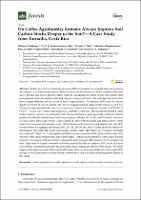| dc.description.abstract | Shaded perennial agroforestry systems (AFS) are regarded as desirable land-use practices that improve soil carbon sequestration. However, most studies assume a positive correlation between above ground and below ground carbon without considering the effect of past and current land management, textural variations (silt and clay percentage), and such other site-specific factors that have a major influence on the extent of soil C sequestration. We assessed SOC stock at various depths (0–10, 10–30, 30–60, and 60–100 cm) in shaded perennial coffee (Coffea arabica L.) AFS in a 17-year-old experimental field at theCentro Agronómico Tropical de Investigación y Enseñanza, (9◦5304400 N, 83◦4007 00 W; soil type: Ultisols and Inceptisols, Turrialba, Costa Rica. The treatments included coffee (Coffea arabica L.) grown conventionally (with chemical fertilizers) and organically (without chemical fertilizers) under two shade trees, Erythrina poeppigiana (Walp.) O.F. Cook., and Terminalia Amazonia J.F.Gmel., Sun Coffee (Coffea arabica L.) (Sole stand of coffee without shade), and Native Forest. Three replicated composite soil samples were collected from each system for each depth class, and SOC stocks in three soil aggregate fractions (2000–250 μm, 250–53 μm, and <53 μm) and in the whole soil determined. The total SOC stocks were highest under forest (146.6 Mg C ha−1) and lowest under sun coffee (92.5 Mg C ha−1). No significant differences were noted in SOC stock within coffee AFS and sun coffee across fraction sizes and depth classes. Organic management of coffee under heavily pruned E. poeppigiana, with pruned litter returned to soil, increased SOC stocks for 0–10 cm depth soil only. High input of organic materials including pruned litter did not improve SOC stocks in deeper soil, whereas variations in silt and clay percentages had a significant effect on SOC stocks. The study suggests that high amounts of aboveground biomass alone are not a good indicator of increased SOC storage in AFS, particularly for soils of sites with historical characteristics and management similar to this study. | es_ES |


